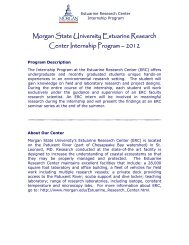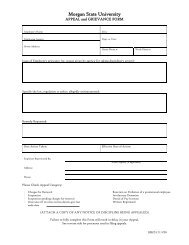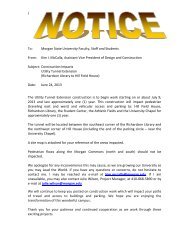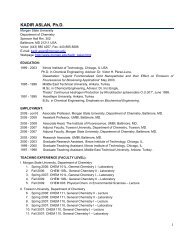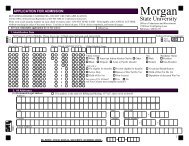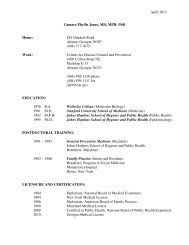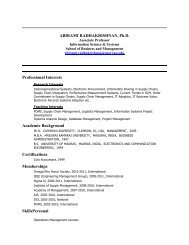FACULTY HANDBOOK July 2009 - Morgan State University
FACULTY HANDBOOK July 2009 - Morgan State University
FACULTY HANDBOOK July 2009 - Morgan State University
You also want an ePaper? Increase the reach of your titles
YUMPU automatically turns print PDFs into web optimized ePapers that Google loves.
PAGE 112 * <strong>Morgan</strong> <strong>State</strong> <strong>University</strong> Faculty Handbookstandard shall be the perspective of a reasonable person within the <strong>University</strong>community. In determining whether alleged conduct constitutes sexualharassment. The <strong>University</strong> will look at the record as a whole and at the totality ofthe circumstances such as the nature of the sexual advances and the context inwhich the alleged incidents occurred. The determination of the legality of aparticular action will be based on the findings of fact on a case by case basis. Therules of common sense and reason shall prevail.III.INFORMAL RESOLUTIONIn certain cases, where the nature of an alleged incident may not be so serious that the<strong>University</strong> must intervene in a formal way and the Complainant indicates that she or hedoes not want to pursue a formal complaint but simply wants the harassment to stop,informal resolution may be the preferred way to handle a complaint. However,informal resolution must always be voluntarily agreed to in writing by theComplainant with no requirement that the Complainant use informal procedures beforefiling a formal charge. The individual is free to withdraw from informal proceduresaltogether and file formally within the institution.The <strong>University</strong> will always investigate a matter even when the Complainant refuses tofile a formal complaint. However, when the <strong>University</strong> and Complainant agree tohandle the matter informally, a formal investigation will not ensue as provided for insection IV of this policy.The informal manner in which an incident is handled will depend upon the severity ofthe incident and the wishes of the Complainant. Possible alternatives include but arenot limited to: the Complainant telling the alleged offender the behavior is unwelcomeand must stop; the Complainant mailing or placing a copy of the sexual harassmentpolicy in the alleged offender’s mailbox after circling the applicable portion of thepolicy; the Complainant sending a letter to the alleged offender, giving a factualaccount of what happened, describing the writer’s feelings about what happened,describing what the writer wants to happen next (e.g., “I want your behavior to stop.”)and delivery of the letter by certified mail.IV.PROCEDURES FOR FILING FORMAL COMPLAINTS OF SEXUALHARASSMENTA. Formal Complaints of Sexual Harassment1. A formal complaint occurs when: (a) a person who believes that he/she has beenthe victim of sexual harassment in the <strong>University</strong> community; or <strong>University</strong>employee with knowledge of the allegations, notifies the <strong>University</strong>'s EqualOpportunity Officer, General Counsel, or Director of Human Resources of theallegations. If either the General Counsel or Director of Human Resources receivesnotification, they shall promptly refer the notice to the Equal Opportunity Officer orsuch other person designated by the President. The person who complains, who isreferred to as the "Complainant", may be a <strong>University</strong> employee, student, staff orfaculty member. The Complainant will be interviewed by the Equal OpportunityOfficer or such other person designated by the President and asked to provide awritten statement of his/her complaint but is not required to do so.



